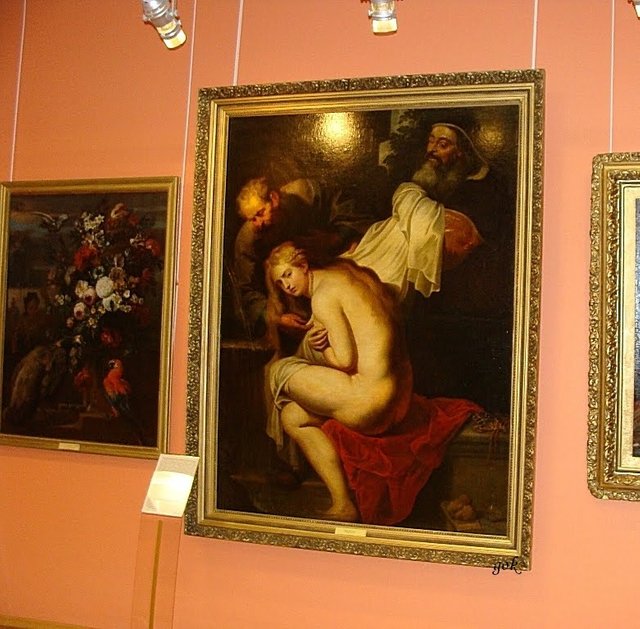European art
To allay the appropriate weather, mood, time to switch the gaze on something beautiful. So I went to the Museum of fine arts to the exhibition "European art of the 1st floor.17 – 19 centuries".
Modern man the art of the relevant period attractive. In the 17th and 18th centuries was dominated by 2 styles: Baroque and classicism, what clearly demonstrates the exposition.
In the development of the Italian Baroque played a major role in the work of Caravaggio (1573-1610) is a technique of mural the entire 16th century. In the early 17th century caravaggism faced art academic direction (the brothers Annibale and Agostino Carraci), which has been focused on the intellectual art movement of art associated with literary works, for example, myths, stories from the Bible. If in the 17th century Baroque and classicism operate in parallel, in the 18th century classicism prevails. There is a kind of school of the Netherlands, representing the pattern of small forms. Their work was also called "the window of the world truthful without embellishment". For painting of the 19th century. Characterized by the interaction of romanticism and realism.
For example, some of the paintings. "Madonna", early 18th century. Nicolò bambini(1651-1739 d. d).


"The sacrifice of Jephthah", the 17th century by an Unknown master. The picture painted in the story of the Greek myth of the warrior Jephthah promised the gods for the victory to bring them to the sacrifice of the one who 1st come to meet him on his return home. Ironically, the first ran towards him his daughter. The picture of Jephthah fulfill the promise.
The painting "Hercules at the Omphalos", of the 18th century Made by the Dutch artist also in the story of the myth. Hercules, aka Hercules was exiled for 3 years as a slave to Queen Omphale, who made him do women's work, and ryadili him in women's clothes, and she wore the lion's skin of Hercules.

Portrait of Cleopatra , Jan de Ban (1633-1702 g), who worked in Rembrandt's workshop, because the lighting effects in "Cleopatra" is close to the style of Rembrandt.

Susanna and the elders by Rubens Peter Pauli (1577-1640). The story of the old Testament: elders caught Susanna in the garden while bathing and harassed her. Having been refused, they accused her of betraying her husband. Susanna was condemned to death, but Daniel saved her by asking each of the elders separately under which tree he met her. Their different answers of the elders was caught in a lie.
Right to left: "market City", Saverio Della Gatta; "Cecilia, by Carlo Dolce (1616-1686), but a copy, executed in the 19th century, but it's pretty good. And last in the picture "Christ and the Samaritan woman" by an unknown Italian artist of the 19th century., however, the picture is hard to see the picture, but believe me, very nicely done a true representative schools of the past era.
2nd hall the exhibition presents paintings of artists of German and French painting of the 19th century. Such as Happel. Peter Henry (1813-1854), surprisingly well and starpulse depicting fine details on the canvas (people, animals).
Rebel Joseph (1787-1828) in his painting "the Night", 1825, gave amazing color transitions (a favorite motif of the romantics): icy cold colors of the moon, a bright flame of fire, and red tongue of fire on the summit of Vesuvius, showing the collision of cold and warm colors. No, words can not convey the power of the feelings from the picture. Its a must see.
Interesting painting of "Judith with the head of Holofernes". Original Aug Ridle (1799-1883) stored in the collection of the Neue Pinakothek in Munich, and we have a copy, executed by the son and disciple of Karl Ridle (1830-1906), established in 1840. on special order.

In addition to paintings, which are much more than mentioned here, the exhibition features marble sculptures, porcelain, vases, furniture of the era. In short, the exhibition not only leaves a positive impression, but also enriches the cultural knowledge.
Source: https://olgagok.blogspot.bg/2012/02/blog-post_15.html
Is this your personal blog: https://olgagok.blogspot.bg/2012/02/blog-post_15.html
Seems like you have translated the text there from Russian to English, but you are not citing the source...
Source: https://olgagok.blogspot.bg/2012/02/blog-post_15.html
Not citing sources of copied works is plagiarism and frowned upon by the community.
Sharing content and add value by:
Repeated plagiarized posts are considered spam. Spam is discouraged by the community, and may result in action from the cheetah bot.
Creative Commons: If you are posting content under a Creative Commons license, please attribute and link according to the specific license. If you are posting content under CC0 or Public Domain please consider noting that at the end of your post.
Not indicating that the content you copy/paste is not your original work could be seen as plagiarism.
If you are actually the original author, please do reply to let us know!
Thank You! ☙
Sorry I didn't know what to do. It won't happen again.
Thank you.